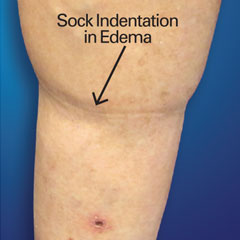
 What Causes Swelling in the Legs?
What Causes Swelling in the Legs?
An abnormal buildup of fluid in tissues called edema is what causes swelling in the legs. In some cases, edema that results in painful swollen legs and ankles can be caused by lymphatic dysfunction. In other cases, edema can result from long-standing venous reflux, a venous disease that causes spider veins and varicose veins and can lead to more serious conditions, such as skin discoloration or venous ulcers.
Bulging and swollen veins may appear in cases of edema caused by venous reflux. These veins typically resemble varicose veins, which are twisted veins that bulge near the surface. In other cases, edema caused by venous reflux can occur without the appearance of bulging veins.
Where Does Swelling Appear?
Edema typically causes swelling first in the area around the ankle bones and then spreads to the lower legs, calves and feet.
Those that suffer painful swollen legs and ankles from edema, the swelling may be constant or it could vary throughout the day. In cases of constant edema, lymphedema may also be a contributing factor. Since swelling often decreases with leg elevation, it may be less visible in the morning, after a night of rest, and more visible in the evening, after a day of sitting, standing, and walking.
What Causes Swelling in the Legs Related to Edema?
While edema in legs can be caused by lymphatic dysfunction or even a blood clot, painful swollen legs and ankles can also be caused by the progressive stages of venous disease. In these cases, venous reflux forces fluids to collect and pool in the tissues around the ankle and lower legs, causing the tissues to swell.
Several factors can contribute to the venous reflux that causes edema:
- Genetics — Determines more than anything else whether a patient will develop vein disease
- Obesity or weight gain — Excessive weight causes vein disease to progress more quickly
- Prolonged sitting or standing — Lack of physical activity from sedentary lifestyles and certain occupations prevents muscles from helping pump blood
- Gender — Vein disease is more common among women
- Pregnancy — Elevated blood volume, hormone levels and pressure on the leg veins due to an enlarging uterus
- Surgery or injury (especially near the pelvis) — Veins that are damaged can restrict blood flow from the legs back to the heart
- Blood clot — Clots that form inside veins can cut off blood flow entirely
Symptoms Related to Edema and Painful Swollen Legs and Ankles
Edema that causes swelling in the legs from venous reflux can lead to several symptoms:
- Swelling in the areas around the ankle and lower leg
- Puffiness of the skin, which may cause it to appear stretched and shiny
- Thinning of the skin
- Pain in and around the affected areas, most notably the ankle and calf
Treatment for Painful Swollen Legs and Ankles
It is difficult to predict how much swelling resolution will be achieved from endovenous thermal ablation or foam sclerotherapy due to the complexity and multiple factors that can cause swelling, including heart failure, kidney and liver diseases, and obesity.
If the cause of edema is determined to result from venous reflux and components of lymphatic dysfunction, lymphedema therapy may be required in addition to endovenous ablation and foam sclerotherapy. Vein treatment will bring some relief in such cases, but the lymphatic dysfunction must also be addressed for patients to achieve maximum relief and a significant reduction in swelling.
Have Questions?
Call our offices in Beaumont – 409.924.8600, Corpus Christi – 361.882.4000, or contact us for more information.
You can also read about swollen legs in our FAQ.